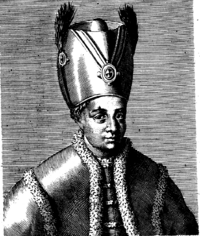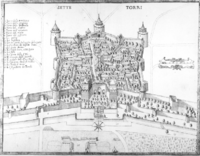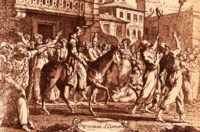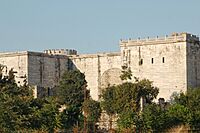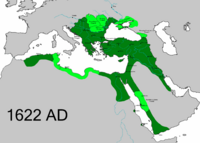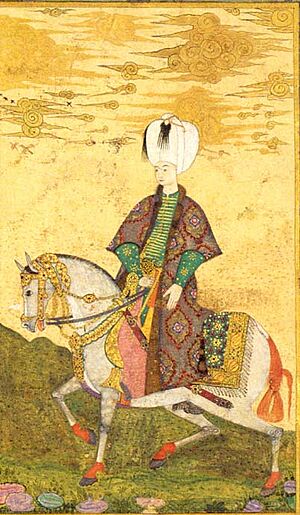Osman II facts for kids
Quick facts for kids Osman II |
|||||
|---|---|---|---|---|---|
| Custodian of the Two Holy Mosques Ottoman Caliph Amir al-Mu'minin |
|||||
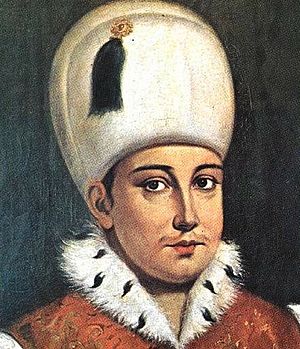 |
|||||
| Sultan of the Ottoman Empire (Padishah) | |||||
| Reign | 26 February 1618 – 20 May 1622 | ||||
| Predecessor | Mustafa I | ||||
| Successor | Mustafa I | ||||
| Born | 3 November 1604 Topkapı Palace, Constantinople, Ottoman Empire |
||||
| Died | 20 May 1622 (aged 17) Yedikule Fortress, Constantinople, Ottoman Empire |
||||
| Burial | Sultan Ahmed Mosque, Istanbul | ||||
| Consorts | Ayşe Sultan Meylişah Hatun Fülane Hatun Akile Hatun |
||||
| Issue | Şehzade Ömer Şehzade Mustafa Zeynep Sultan |
||||
|
|||||
| Dynasty | Ottoman | ||||
| Father | Ahmed I | ||||
| Mother | Mahfiruz Hatun | ||||
| Religion | Sunni Islam | ||||
| Tughra |  |
||||
Osman II (born November 3, 1604 – died May 20, 1622), also known as Osman the Young, was the sultan of the Ottoman Empire. He ruled from February 26, 1618, until he was killed on May 20, 1622.
Contents
Early Life of Osman II
Osman II was born in Topkapı Palace in Constantinople (modern-day Istanbul). He was the son of Sultan Ahmed I. From a young age, Osman received a good education. He was known for being smart and was believed to have learned many languages. These included Arabic, Persian, Greek, Latin, and Italian.
Osman was trained within the palace. People from other countries who observed him said he was one of the most educated Ottoman princes.
Osman II's Time as Sultan
Osman II became sultan when he was only 14 years old. This happened after his uncle, Mustafa I, was removed from power. Even though he was young, Osman II quickly wanted to show he was a strong ruler.
First, he made peace on the empire's eastern border. He signed a treaty with Safavid Persia. After that, he personally led the Ottoman army against Poland. This was during the Moldavian Magnate Wars.
In 1621, Osman's army faced the Poles at the Battle of Khotyn. The battle did not go well for the Ottomans. Osman II had to sign a peace treaty that was not favorable to him. He returned to Constantinople feeling ashamed. He blamed his army, especially the Janissaries, for the defeat. The Janissaries were special infantry units of the Ottoman army.
Osman II faced challenges because he lacked strong support from women in the palace. In the Ottoman system, the Sultan's mother, called the valide sultan, often had great power. Osman did not have this kind of strong female support. This made it harder for him to control the politics of the palace.
In 1620, Osman decided to go on another campaign against Poland. He was determined, even with cold weather and food shortages. The Janissaries and the army were not eager to fight in such harsh conditions.
The Great Winter of 1621
In January 1621, a very severe snowstorm hit Istanbul. The cold was extreme and caused many problems for the people. It was the biggest natural disaster during Osman's short rule.
Some historical accounts say that the Golden Horn and the Bosphorus, which are waterways in Istanbul, froze over. People could even walk across the ice from one side to the other. This extreme cold led to a severe food shortage in Istanbul. Prices for basic foods like bread and meat rose very high.
Death of Osman II
Osman II wanted to reduce the power of the Janissaries. He closed their coffee shops, which were places where they often planned against the Sultan. He also started to plan a new army made of loyal soldiers from Anatolia.
These actions angered the Janissaries. They started an uprising against the young sultan. They captured Osman II and imprisoned him in Yedikule Fortress in Istanbul. There, Osman II was tragically killed. This was a very important event in Ottoman history. It was the first time a sultan was executed by the Janissaries.
Family of Osman II
Osman II had several wives and children.
Wives
- Ayşe Sultan: She was one of Osman's wives. Not much is known about her life.
- Meylişah Hatun: She was a favorite wife of Osman. She was the mother of his oldest son, Şehzade Ömer.
- Fülane Hatun: She was the daughter of an astrologer. She was a free Muslim woman and Osman's first legal wife. Their marriage was unusual because sultans did not usually marry free Ottoman women.
- Rukiye Akile Hatun: She was the daughter of a religious scholar. She was also a free Muslim woman and Osman's second legal wife.
Sons
- Şehzade Ömer (born October 20, 1621 – died February 5, 1622): He was the son of Meylişah Hatun. His birth was celebrated by his father. He died very young, possibly in an accident.
- Şehzade Mustafa (born November 1622 – died 1623): He was born after his father's death. His mother's identity is not certain. He also died very young.
Daughters
- Zeynep Sultan (born November 1622 – died around 1623): She was the twin sister of Şehzade Mustafa. She was also born after her father's death. She died as a baby.
See also
 In Spanish: Osmán II para niños
In Spanish: Osmán II para niños
- Transformation of the Ottoman Empire



